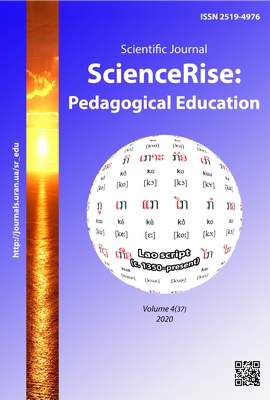Training of teachers-defectologists in the conditions of modern labor migration
DOI:
https://doi.org/10.15587/2519-4984.2020.203328Keywords:
labor migration of teacher-defectologists, special education, inclusive education, children with special educational needsAbstract
The study theoretically substantiates and experimentally tests the key aspects of preparing defectologists (speech therapists) to work with children with special educational needs in modern inclusive education institutions.
An analysis of the current state of the implementation of correctional and developmental work with primary school students with special educational needs - intellectual disabilities of varying severity, showed the existence of a certain range of problems.
It was found, that the acute problem of interpreting speech disorders in a selected category of children remains within the framework of the modern speech therapy psychological and pedagogical classification, conducting a comprehensive clinical screening. Already at the stage of diagnosis, modern defectologists have insufficient pedagogical tools to install and identify the corresponding type of disorders of psychophysical development.
The modern system of inclusive education requires the multidisciplinary knowledge of teachers, teacher assistants to carry out effective educational and pedagogical activities with the selected category of students not so much in modern special educational space as in inclusive education.
Today's requirements are the training of “universal” defectologists for inclusive education institutions. Given the mass labor emigration due to the unstable socio-economic situation in the country, the constant shortage of qualified teachers to work with children with special educational needs remains relevant in the labor market.
The analysis of educational documentation (curricula, working educational programs) in higher educational institutions for the training of students of specialty 016 Special education revealed the absence of relevant academic disciplines. The content of which reveals the applied aspects of the formation and correction of the speech activity of children with special educational needs, which contributed to the mastery of students' theoretical and practical knowledge about the specifics of the implementation of correctional development (logocorrectional) work with the selected category of children.
Contributing to the solution of this problem is the need to introduce in the curricula of higher education institutions that train specialists in specialty 016 Special Education, for the cycle of selective disciplines of professional and practical training of future psychocorrectional teachers and speech therapists of the corresponding discipline or the inclusion of their individual modules (sections) in other related disciplines
References
- Boriak, O. (2015). Language and Speech Functional System under Development Pathologies (Mental Retardation). International Journal of Pedagogy, Innovation and New Technologies, 2 (1), 69–75. doi: http://doi.org/10.5604/23920092.1159142
- Bates, E., Thal, D., Janowsky, J.; Rapin, I., Segalowitz, S. (Eds.) (1992). Early language development and its neural correlates. Handbook of neuropsychology. Vol. 7: Child neuropsychology. Amsterdam: Elsevier. Available at: https://www.researchgate.net/publication/2593157_Early_Language_Development_And_Its_Neural_Correlates
- Cannon, M. J., Davis, K. F. (2005). Washing our hands of the congenital cytomegalovirus disease epidemic. BMC Public Health, 5 (1). doi: http://doi.org/10.1186/1471-2458-5-70
- Das, J. P., Kirby, J., Jarman, R. F. (1975). Simultaneous and successive synthesis: An alternative model for cognitive abilities. Psychological Bulletin, 82 (1), 87–103. doi: http://doi.org/10.1037/h0076163
- Carr, D., Felce, D. (2000). Application of stimulus equivalence to language intervention for individuals with severe linguistic disabilities. Journal of Intellectual & Developmental Disability, 25 (3), 181–205. doi: http://doi.org/10.1080/13269780050144262
- Evans, J. L., Saffran, J. R., Robe-Torres, K. (2009). Statistical Learning in Children With Specific Language Impairment. Journal of Speech, Language, and Hearing Research, 52 (2), 321–335. doi: http://doi.org/10.1044/1092-4388(2009/07-0189)
- Duker, P., Rikken, A. (1989). Assessing transparency of communicative gestures for mentally handicapped individuals. International Journal of Rehabilitation Research, 12 (3), 318–319. doi: http://doi.org/10.1097/00004356-198909000-00010
- Field, M. A., Sancher, V. A. (1999). Equal Treatment for People with Mental retardation. Combridge: Harvard University Press.
- Sheremet, M. (2013). Fiziolohichni i psykholohichni peredumovy movlennievoho rozvytku ditei u normi i patolohii. Naukovyi chasopys NPU imeni M. P. Drahomanova, 23, 298-301.
- Shipicyna, L. M. (2005). «Neobuchaemyi» rebenok v seme i obshchestve. Socializaciya detei s narusheniem intellekta. Saint Petersburg: Rech, 477. Available at: https://studfiles.net/preview/4654234/
Downloads
Published
How to Cite
Issue
Section
License
Copyright (c) 2020 Oksana Boriak, Vadym Makhonia

This work is licensed under a Creative Commons Attribution 4.0 International License.
Our journal abides by the Creative Commons CC BY copyright rights and permissions for open access journals.
Authors, who are published in this journal, agree to the following conditions:
1. The authors reserve the right to authorship of the work and pass the first publication right of this work to the journal under the terms of a Creative Commons CC BY, which allows others to freely distribute the published research with the obligatory reference to the authors of the original work and the first publication of the work in this journal.
2. The authors have the right to conclude separate supplement agreements that relate to non-exclusive work distribution in the form in which it has been published by the journal (for example, to upload the work to the online storage of the journal or publish it as part of a monograph), provided that the reference to the first publication of the work in this journal is included.








